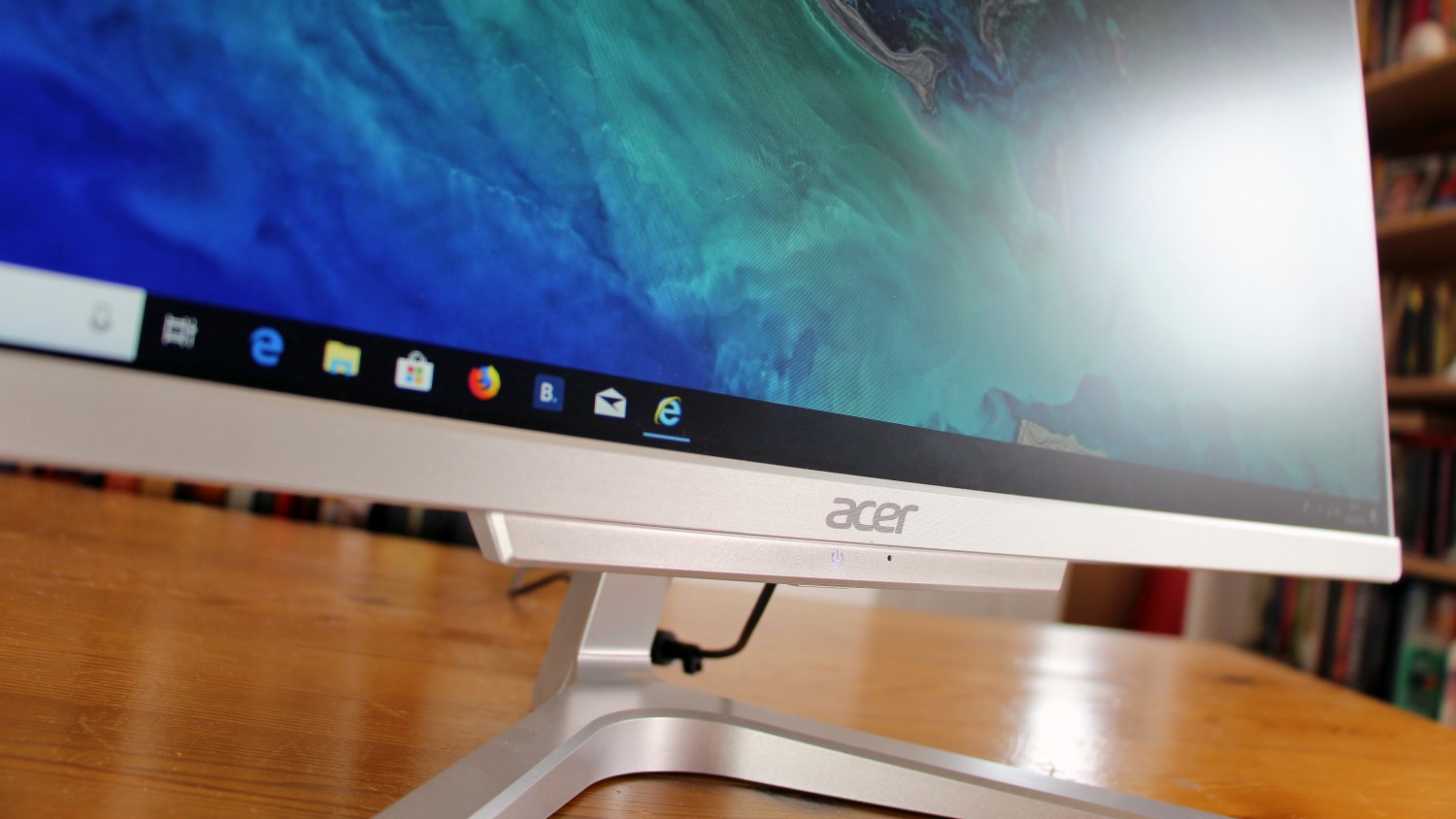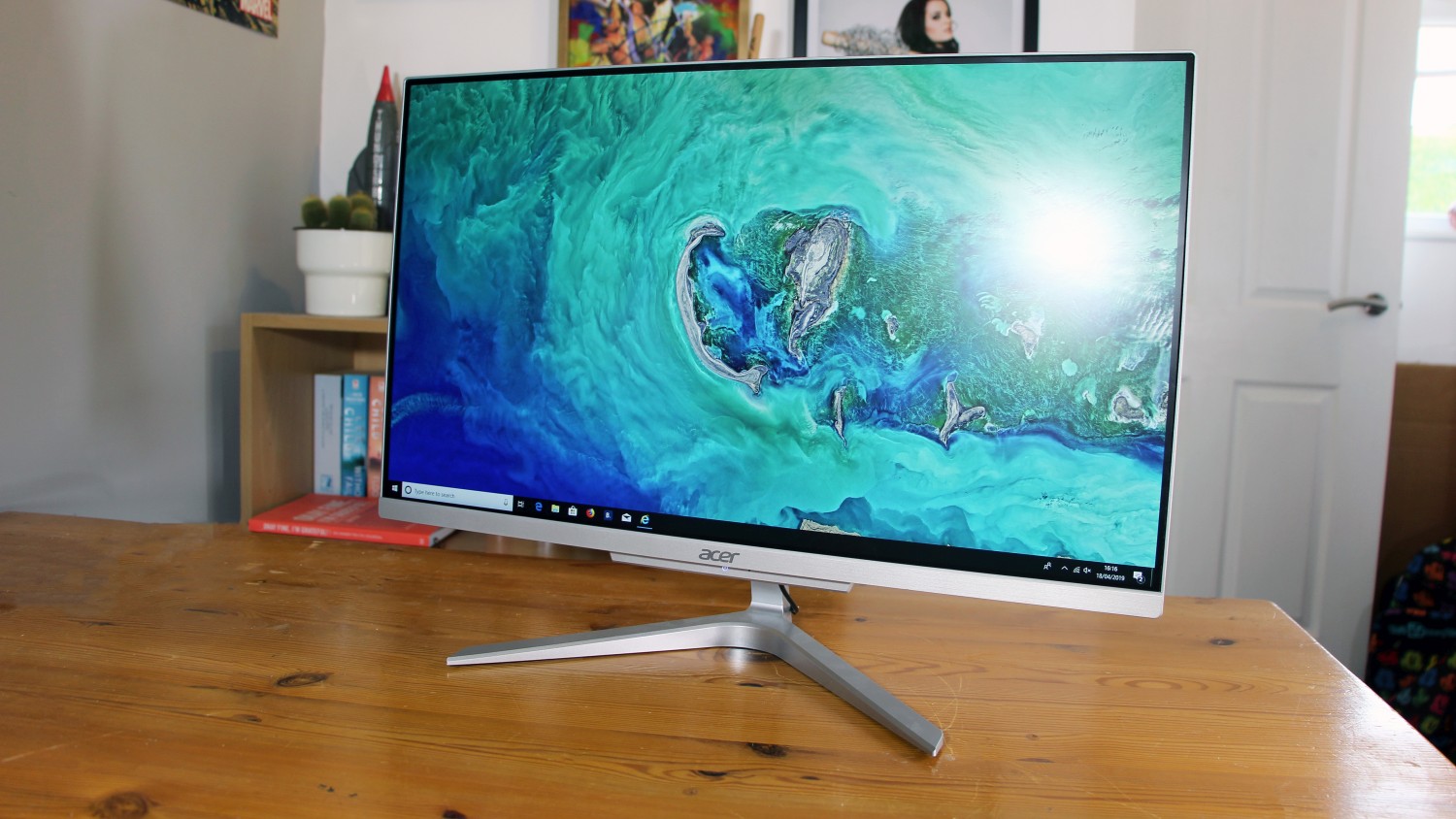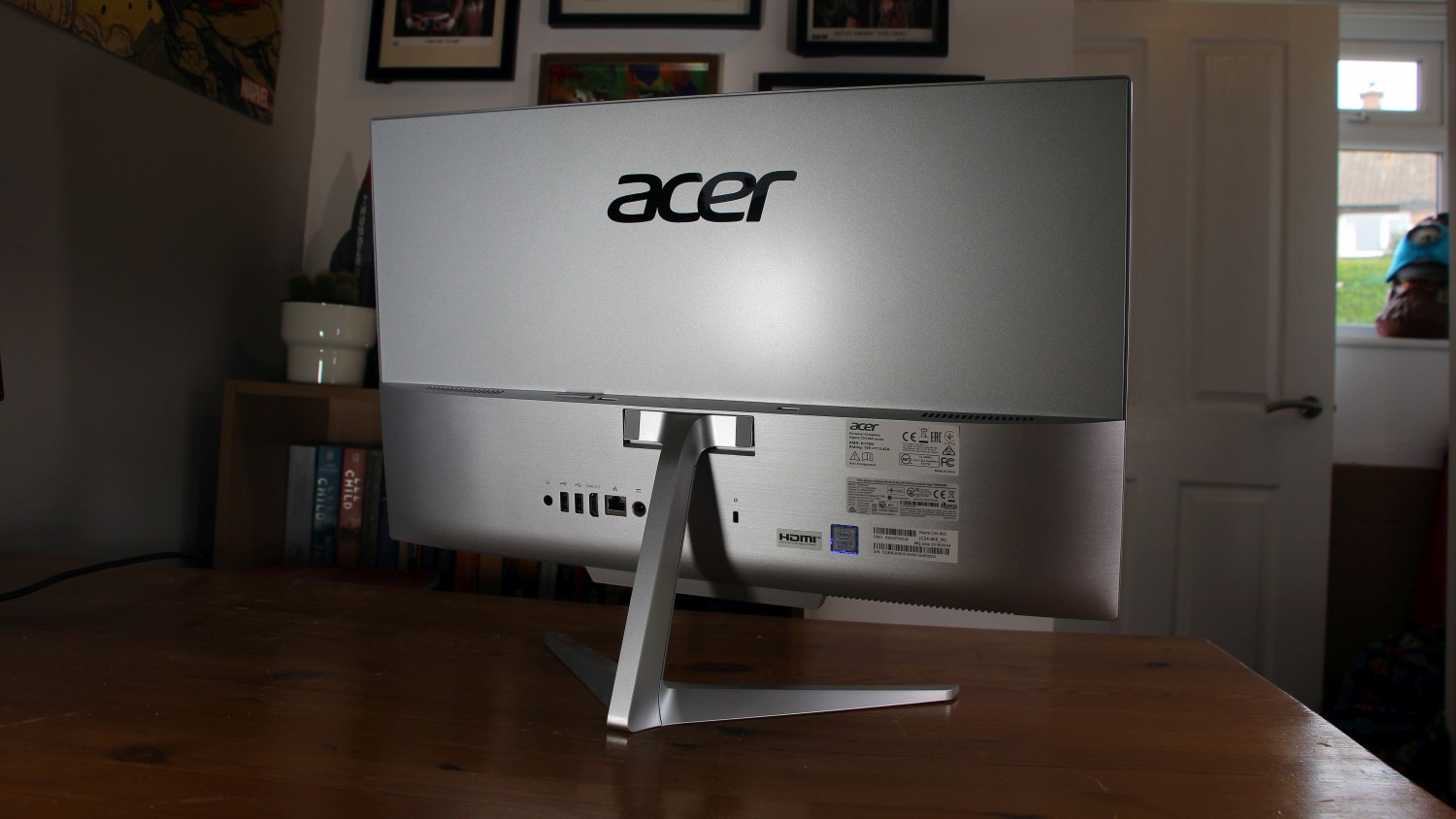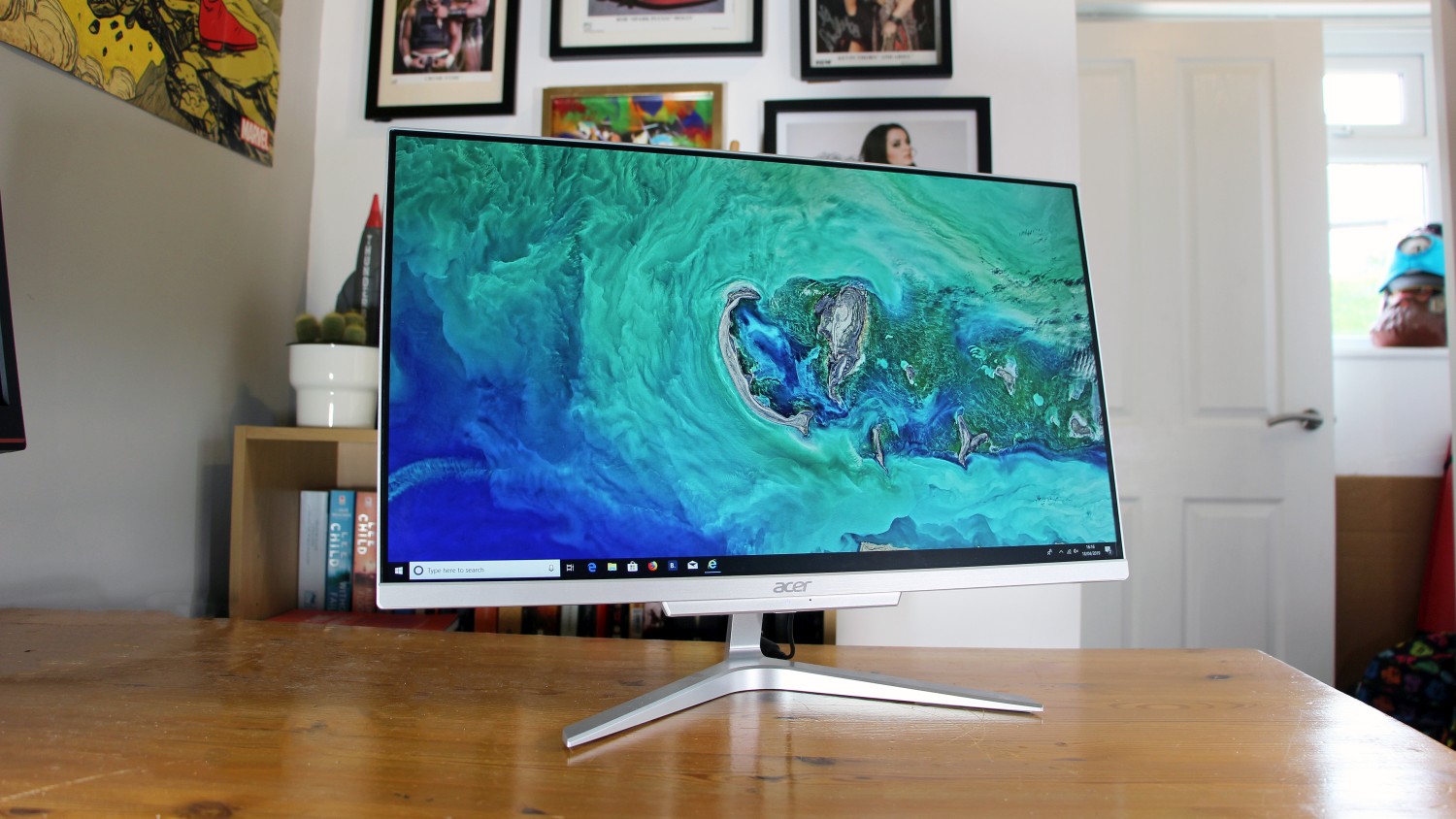TechRadar Verdict
The Acer Aspire C24 looks good, is sturdy enough and has a good 1080p screen, but the Core i5 CPU is undermined by a slow hard disk that makes using this machine a frustrating experience. If you’re still tempted, the Core i3 version with an SSD is a better option by far.
Pros
- +
Good design and build qualitY
- +
Solid screen results
- +
Far cheaper than rivals
Cons
- -
Horrifically slow hard disk
- -
Connectivity could be better
- -
Poor speakers
Why you can trust TechRadar
Here is the Acer Aspire C24 configuration sent to TechRadar for review:
CPU: 1.6GHz Intel Core i5-8250U (4-core, 6MB cache)
Graphics: Intel HD Graphics 620
RAM: 8GB DDR4
Screen: 24in 1,920 x 1,080 non-touch IPS
Storage: 1TB HDD
Ports: 2 x USB 3.1, 1 x USB 2, 1 x audio, 1 x SD card, 1 x HDMI 2.0
Connectivity: Dual-Band Wireless, Gigabit Ethernet, Bluetooth 4.1
Camera: 5MP (1080p) Windows Hello camera
Weight: 9.4 pounds (4.3kg)
Size: 12.6 x 21.2 x 7.8 inches, 321 x 540 x 200mm (H x W x D)
The all-in-one market has moved towards higher prices over the past couple of years thanks to machines like the Apple iMac and the Microsoft Surface Studio 2, but the Acer Aspire C24 takes a pleasingly affordable approach instead.
This machine only costs $772 (£599, AU$1,102), and it’s designed to tackle mainstream home and office tasks with ease – and to look smart while doing it. That’s great, but we are a little concerned that corners have been cut to meet that affordable price.
Price and availability
There are three Acer Aspire C24 models, and all of them are affordable.
The model we’ve reviewed costs $772 (£599, AU$1,102) and has a Core i5 processor alongside 8GB of memory and a 1TB hard disk. There’s another machine at the same price that includes a Core i3 processor and a 128GB SSD alongside identical hard disk and memory allocations.
And then, finally, there’s a $707 (£549, AU$1,010) version of this machine that includes the Core i3 CPU and 1TB hard disk, but no SSD.

Design
The Aspire C24 doesn’t look a budget machine. It’s made from plastic, but you can’t tell – because the material looks just like metal. It’s got a brushed finish on the main screen bezel and on the rear, and there are no unwanted extras.
The screen itself has pleasingly slim bezels, and build quality is solid too – the plastic at the back barely moves when force is applied, and the screen sits sturdily on its smart base.
Sign up for breaking news, reviews, opinion, top tech deals, and more.
It’s a good bill of health, and the Acer doesn’t take up any more room than a conventional 24in screen. The base occupies nearly 8 inches (200mm) of space from front to back, and the machine only weighs 9.4 lbs (4.3kg) – so it’s easy to move around.

Acer’s machine looks good and feels sturdy, although it obviously can’t compete with PCs from Apple and Microsoft that cost twice as much. Still, it’s a good first impression.
Hands-on time with the Acer reveals some practical areas where it’s a little more ordinary.
The port selection is acceptable but not great. There are two USB 3.1 ports and an SD card reader that face up from the top of the component section, which makes them easier to access. However, those ports use USB 3.1 Gen 1 not Gen 2, so they’re slower – and there are no more convenient ports on the sides of the system.
At the rear you’ll find more ports. However, you only get two slower USB 2 connections alongside an HDMI output and the Gigabit Ethernet port. There’s no USB Type-C, no DisplayPort and only one audio jack.
The Acer’s connectivity is fine for basic desktop peripherals, but it’s not that good for much else.
On the inside, you get dual-band 802.11ac wireless, Gigabit Ethernet and Bluetooth 4.2. Acer has also installed TPM 2.0 here, but there’s no Intel vPro.
Here’s how the Acer Aspire C24 performed in our suite of benchmark tests:
3DMark: Sky Diver: 3651; Fire Strike: 892; Time Spy: 357
Cinebench CPU: 412 points; Graphics: 38.3fps
GeekBench: 3752 (single-core); 11364 (multi-core)
PCMark 8 (Home Test): 3037 points
Middle Earth: Shadow of Mordor: 16fps (1080p, Low); 28fps (720p, Low)
Rise of the Tomb Raider: 7fps (1080p, Low); 12fps (720p, Low)
Performance
The model we’ve reviewed has a Core i5-8250U processor. It’s an eighth-generation Kaby Lake chip, although it’s just been superseded by the i5-8265U and its better Turbo speeds.
Still, the i5-8250U is not obsolete just yet. Its base speed of 1.6GHz is fine, and it reaches a Turbo peak of 3.4GHz. It’s a low-power part, and it still has four cores that use Hyper-Threading – so it can address eight concurrent threads.
The CPU is joined by 8GB of memory, and the Acer uses the integrated Intel UHD Graphics 620 chipset. The specification is fine - on par with mid-range laptops that also drive 1080p screens.
It’s designed for day-to-day computing: web browsing across several tabs, running Office applications, loading a few different apps at once and for media playback. It’s not designed for photo and video editing, content creation, other tough work tasks or for playing the latest games.

Benchmarks suggest that the Acer has the power to fit this remit. Its Geekbench single-core result of 3,752 is middling, but easily enough to handle web browsers and Office tools without any problems.
Its multi-core result of 11,364 shows that you’re getting a solid quad-core boost, and that there’s enough grunt here to handle several relatively undemanding applications at once. Similarly, the Acer’s Cinebench score of 412 points is modest, but enough for day-to-day computing. And, happily, the reliance on low-power hardware means that the Aspire never makes any significant noise.
The new Core i5-8265U will be increasingly popular in the coming months. If you need a little more power, it may be worth waiting for that CPU – it’s around 700 points faster in the Geekbench single-core test, and almost 2,000 points quicker in the multi-core benchmark. The newer Core i5 CPU is around 200 points better in the tough Cinebench test.
If you need a bigger boost to computing power for proper work applications, then you’ll have to step away from low-power Intel CPUs entirely – and opt for a machine that’s bulkier and more expensive.
The Core i5-powered Acer delivers enough benchmark power for day-to-day use on paper – but using the Aspire C24 in real-world applications is far less satisfying.
The big problem is the hard disk. It only rotates at a measly 5,400rpm, and it only delivers read and write speeds of 130MB/s and 108MB/s – miles behind the speeds offered by any decent SSD.
The slow hard disk means that using the Aspire is often frustrating. You may as well make a coffee while you wait for it to boot, and there are noticeable, irritating delays when you load applications, open new browser tabs or even launch the Windows taskbar.
The machine was a tiny bit faster once we’d applied Microsoft’s latest Windows Feature Upgrade, but the performance wasn’t transformed.
Once you get your applications open then the Acer feels snappier, but the frequent pauses and delays are a constant annoyance.
The slow hard disk is disappointing. For this reason, we’re glad that Acer sells a version with a Core i3-8130U processor and a 128GB SSD for the same price.
Switching to the Core i3 CPU sees you lose two cores, which drops its multi-core Geekbench score by around 4,000 points. It still has enough grunt to handle day-to-day computing, office and media tasks, and the SSD will makes the system feel far more responsive. That’s the Aspire C24 we’d buy.

Screen and speakers
The 24in screen is a full HD IPS model without touch, which is as good as anyone can expect for an affordable all-in-one.
And, happily, quality levels are decent. The Acer’s brightness measurement of 261cd/m2 is just high enough to cope with home and office lights, and it’s paired with a black level of 0.24cd/m2. That latter figure is good enough to ensure solid depth to all sorts of images.
Those two measurements create a contrast ratio of 1,088:1. It’s another solid score, and one that guarantees good vibrancy and depth in documents, photos and web pages of all types.
The Acer delivered a color temperature of 6,795K and a Delta E of 2.73. Those results are fine rather than fantastic, and the Aspire rendered a middling 87.1% of the sRGB color gamut.
There isn’t the accuracy or breadth here to handle color-sensitive work, but the Acer isn’t powerful enough for that anyway. Instead, the screen easily has enough depth, vibrancy and variation for web browsing, media playback and Office tools.
The speakers are far worse. There’s no bass, a tinny high-end that’s reminiscent of old, cheap laptops, and the mid-range is far too muddy. Anyone who wants to use the Acer for music or media needs to invest in some external speakers.
Verdict
Acer’s Aspire C24 looks the part, with metal-effect plastic proving eye-catching and a physical design that’s smart and subtle.
It’ll be equally at home in an office or the living room, and build quality is good. You’ve got a couple of USB 3.1 ports and a card reader, decent connectivity inside, and a quad-core Intel Core i5 CPU.
The screen is good, too. It’s got solid contrast and colour accuracy, which means that it easily has the chops to handle web browsing, media duties and some light work.
However, Acer’s machine has a solid processor on paper, but the Aspire’s performance is severely undermined by its hard disk. Opening applications, windows and menus takes an age, and booting is slow. The lack of an SSD hinder every part of this machine, making it consistently frustrating to use.
The speakers are poor, and the Aspire could have better connectivity. But that hard disk is the main issue.
Thankfully, you can buy a model with a Core i3 CPU and an SSD for the same price. You lose some CPU ability, but the SSD makes the whole rig feel far more responsive – so that would be our choice.
That slow hard disk is the Acer’s biggest issue, so let’s say this first: if you’re interested in this machine, choose the model with the SSD and the Core i3 CPU. You’ll lose a little multi-tasking ability, but the entire machine will be far more responsive and usable.
Elsewhere, the Aspire C24 is better. It looks smart, has decent build quality, and the screen is easily good enough for the Acer’s mainstream work and home tasks.
It’s certainly got the screen and build quality to handle general purpose home and office life, and the Core i3 version has the power to handle relatively undemanding software, too.
If you need an affordable all-in-one then the Acer Aspire C24 certainly fits the bill. Just avoid the Core i5 version and make sure you get the Core i3 model with an SSD instead.
Mike has worked as a technology journalist for more than a decade and has written for most of the UK’s big technology titles alongside numerous global outlets. He loves PCs, laptops and any new hardware, and covers everything from the latest business trends to high-end gaming gear.
